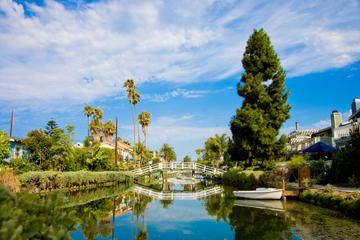Venice Canals and Walkways
TIME : 2016/2/22 16:49:50

Venice Canals and Walkways
In 1905, tobacco millionaire and real estate developer Abbot Kinney sought to simulate the romantic feel of Venice, Italy in America by creating the beach resort town of Venice just south-west of Santa Monica. Kinney wrangled the area's marshland into a series of canals that, initially, were traversed by ornate gondolas piloted by gondoliers in traditional Italian garb.
The first incarnation of Venice also had an elaborate amusement pier, a miniature railroad, and a block-long street of faux-Venetian buildings, all sloping towards a wide swath of Pacific Ocean shoreline. Its commercial success inspired competition from neighboring piers in Santa Monica, but Kinney's Venice held onto its popularity even after 1920 when its founder died and his original pier burned down. Kinney's family rebuilt the pier quickly, creating a series of large-scale amusement rides that could be seen from different vantage points along the canals; this second pier would become one of the most-visited attractions in Los Angeles County throughout the 1920s.
Los Angeles annexed Venice in 1925, but provided little in the way of government infrastructure and waste management. Thus, by the time oil was discovered here in 1929, the Venice canals were already becoming trash-clogged and swampy. City developers with plans for a forest of oil wells and more commercial and residential space filled in many of the maligned canals with asphalt and concrete. Those canals that remained would fall into increasing disrepair for the next 60 years.
Though the Venice Canal District was listed on the National Register of Historic Places in 1982, the canals themselves wouldn't be renovated for another decade. By 1993, when rejuvenation efforts were in full swing along the funky, laid-back and locally beloved Abbot Kinney Boulevard, the canals had been drained and refilled with fresh water that shimmered green in the sunlight, the crumbling walls and surrounding sidewalks were repaired, and several arched bridges had been rebuilt and freshly painted. The area is now one of L.A.'s most desirable neighborhoods, featuring a mix of historic and stylishly modern architecture and a well-landscaped network of walkways. Some residents travel the canals by rowboat and the waterways are also home to small fish, ducks and the occasional heron.
